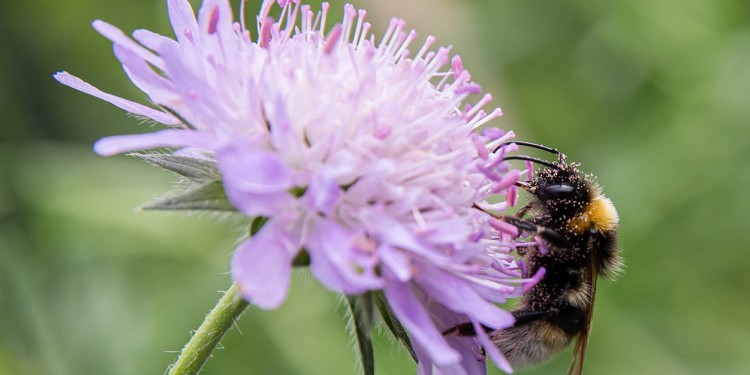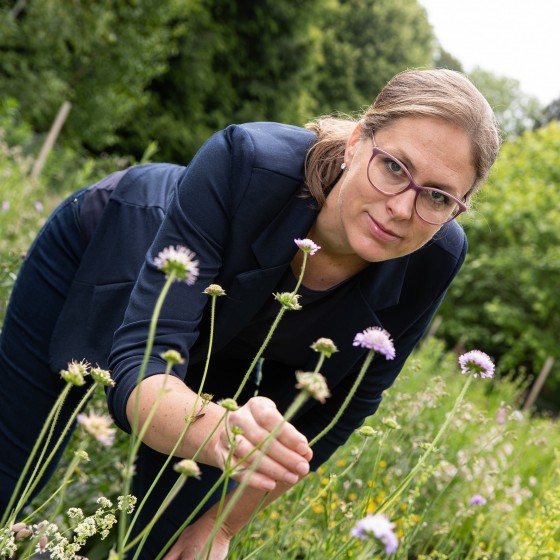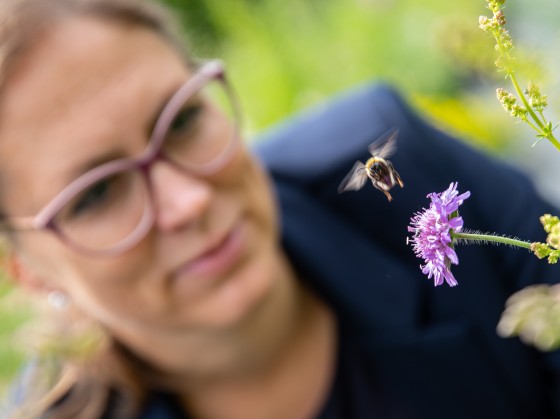
Restoring Nature
An abandoned space in the middle of Münster: in the historic medicinal plant garden, which hasn’t been in use since 2016, nature can pretty much do what it likes. At least, it almost can – anyone who fights their way through an overgrown meadow between Einsteinstraße and Schlossgräfte will come across a clearing, about 50 square metres in size, on which meadow plants are arranged in rows of pots standing on black groundsheets. These are test objects belonging to plant ecologist Dr. Anna Lampei-Bucharova, who chose this place off the beaten track for her research.
Birds twitter and, if you listen carefully enough, you can also clearly hear the buzzing of bumblebees going about their busy work among the yellow and lilac blooms on the plants. It is idyllic, but the experiment also has a serious aim – to repair something that has been destroyed. With her research, Anna Lampei-Bucharova wants to help to restore ecosystems humans have destroyed, for example as a result of construction work or agriculture. And there are many of them. “In the Münsterland there is practically no nature left, apart from small areas here and there,” says Anna Lampei-Bucharova, who is based at the Institute of Landscape Ecology at Münster University.

To get to the bottom of this question, some of the plants being used in the experiment have travelled throughout Germany. For example, plants such as the brown knapweed, the common bird's-foot trefoil and the white bedstraw from Münster stand next to their kindred plants from Munich and Frankurt/Oder in southern and eastern Germany respectively. This is how Anna Lampei-Bucharova and her colleagues investigate how the same species have adapted to their environment. The bumblebees are not just bit players in this spectacle – they are important participants in the experiment, because the researchers want to find out not only whether the plants differ from one another as a result of their origins, but also whether they have different effects on their pollinators.
Anna Lampei-Bucharova looks with interest from bloom to bloom. In every one of the small groups into which she has divided the plants, she discovers at least one insect buzzing around or at rest. Three different types of bumblebee are regular visitors – and even the non-specialist can see from the colouring of their coats that they differ from one another. Students regularly, and at different times, come to see what is going on in this microcosmos. Initial findings show that the plants – which at first sight look the same – do in fact exert different forces of attraction on the selective insects.
“We have already found out that the plants from the Munich region attract twice as many pollinators – and, at the same time, give rise to twice as many interactions – as other plants,” Anna Lampei-Bucharova explains. An interaction is, for example, flying from one bloom to another. The reason for these differences is that some of the plants begin to flower earlier than the others because they have adapted to the climatic conditions in their original region. In addition, some of the plants vary greatly in size. In the lab, the researchers also investigate how they differ genetically.

“We’re researching into something that gives cause for hope. It’s all about finding solutions and about helping wherever there is nothing left,” says Anna Lampei-Bucharova. But, despite being hopeful, she makes the qualification that “ecosystems which have been lost cannot be restored to what they once were. That should be taken into account in every building project, even if compensatory areas are included in the planning.”
She is convinced that nature can be repaired in parts. “Awareness of the subject of sustainability is changing more and more in our society,” she says. So hopefully we will be soon able to watch the bumblebees buzzing around the brown knapweed and the other plants at more and more places in Münster and beyond.
Author: Svenja Ronge
This article was first published in the University newspaper wissen|leben, No. 4, 17 June 2020.
